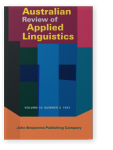Speech reporting as a discourse strategy
Some issues of acquisition and use
This paper examines approaches to the analysis of speech reporting, finding that these approaches fall into two broad categories: traditional approaches which emphasize the syntactic dimension of speech reporting and are informed by an autonomous model of language and discourse pragmatic approaches which emphasize the interaction of syntactic, pragmatic and stylistic factors in discourse. A model for speech reporting strategies in discourse is proposed, involving direct and indirect speech reporting strategies and a ‘lexicalization strategy’. Using this model, a number of approaches to the function of direct speech reporting strategies in the early stages of SLA are reviewed, which analyze the function of direct speech reporting as a ‘compensatory discourse strategy’, not as stylistic variation. It is argued that this analysis is informed by the traditional approach to speech reporting and does not take into account the ‘lexicalization strategy’. When the lexicalization strategy is considered, direct speech is found to function both referentially and stylistically in learner discourse. The argument is illustrated via an analysis of speech reporting in narrative in learner varieties of English and German.
References (32)
Banfield, A.
(
1982)
Unspeakable sentences: Narration and representation in the language of fiction. London, Routledge & Kegan Paul.

Bauman, R.
(
1977)
Verbal art as performance. Rowley, Mass, Newbury House.

Baynham, M.J.
(
1988)
Narrative and narrativity in the English of a first generation migrant community. Unpublished PhD thesis, University of Reading.

Colin, G.S.
(
1939)
Chrestomathie Marocaine. Paris, Publications de l’Institut des Hautes Etudes Marocaines.

Coulmas, F.
(
1985)
Direct and indirect speech: general problems and problems of Japanese.
Journal of Pragmatics 91: 41–63.


Eco, U.
(
1979)
The role of the reader: Explorations in the semiotics of texts. London, Hutchinson.

Faerch, K. & G. Kasper
(
1983)
Strategies in interlanguage communication. London, Longman.

Genette, G.
(
1980)
Narrative discourse. Oxford, Blackwell.

Givon, T.
(
1979)
From discourse to syntax: grammar as a processing strategy. In
T. Givon (ed.) Syntax and semantics, vol. 121,
Discourse and syntax. New York, Academic Press.


Godfrey, D.L.
(
1980)
A discourse analysis of tense in adult ESL monologues. In
D. Larsen-Freeman (ed.)
Discourse analysis and second language research. Rowley, Mass, Newbury House.

Goffman, E.
(
1981)
Forms of talk. Oxford, Blackwell.

Gumperz, J.J.
(
1982)
Discourse strategies. Cambridge, Cambridge University Press.


Halliday, M.A.K.
(
1985)
An Introduction to functional grammar. London, Edward Arnold.

Hymes, D.
(
1972)
Editorial introduction to Language in Society.
Language in Society 1,1: 1–14.


Klein, W.
(
1986)
Second language acquisition. Cambridge, Cambridge University Press.


Klein, W. and N. Dittmar
(
1979)
Developing grammars: the acquisition of German syntax by foreign workers. Berlin, Springer Verlag.


Labov, W. & J. Waletzky
(
1967)
Narrative analysis: oral versions of personal experience. In
J. Helm (ed.)
Essays on the verbal and visual arts. Seattle, University of Washington Press.

Levelt, W.
(
1981)
The speaker’s linearization problem.
Philological Transactions of the Royal Society of London, Series
B: 295, 305–315.


Lyons, J.
(
1968)
Theoretical linguistics. London, Cambridge University Press.

McHale, B.
(
1978)
Free indirect discourse: a survey of recent accounts.
Poetics and Theory of Literature 31: 249–287.

Mittner, M.
(
1984)
About temporal reference in a Spanish speaking migrant worker’s personal narratives. In
Second language acquisition by adult immigrants, European Science Foundation. London, National Centre for Industrial Language Training.

Page, N.
(
1973)
Speech in the English novel. London, Longman.

Partee, B.
(
1973)
The syntax and semantics of quotations. In
P. Kiparsky and
S. Anderson (eds)
A Festschrift for Morris Halle. New York, Holt, Rinehart and Winston.

Rimmon-Kenan, S.
(
1983)
Narrative fiction: Contemporary poetics. London, Methuen.


Rosen, H.
(
1979)
The dramatic mode. In
P. Salmon (ed.)
Coming to know. London, Routledge & Kegan Paul.

Schumann, J.
(
1979)
The pidginization process: a model for second language acquisition. Rowley, Mass., Newbury House,

von Stutterheim, C.
(
1984)
Temporality in learner varieties.
Linguistische Berichte 821: 31–45.

von Stutterheim, C. and W. Klein
(
1984)
A concept-oriented approach to second language studies. In
R.W. Andersen (ed.)
First and second language acquisition processes. Rowley, Mass., Newbury House.

Volosinov, V.N.
(
1978)
Reported speech. In
L. Matjeka and
K. Pomorska (eds)
Readings in Russian poetics. Ann Arbor, Mich., Michigan Slavic Contributions.

Wiggen, G.
(
1981)
Spontaneous dramatization in semi-formal conversation. Oslo, TAUS Skrift No. 9.

Wolfson, N.
(
1982a)
CHP:
The conversational historical present in American English narrative. Dordrecht, Foris.


Wolfson, N.
(
1982b)
On tense alternation and the need for analysis of native speaker usage in second language acquisition.
Language Learning 321, 53–68.


Cited by (1)
Cited by 1 other publications
Baynham, Mike
1996.
Direct speech: What's it doing in non-narrative discourse?.
Journal of Pragmatics 25:1
► pp. 61 ff.

This list is based on CrossRef data as of 29 june 2024. Please note that it may not be complete. Sources presented here have been supplied by the respective publishers.
Any errors therein should be reported to them.
